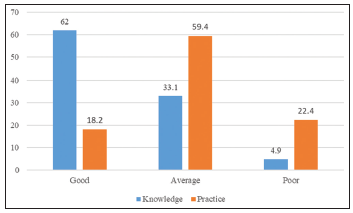Public health challenges in households - Food safety
DOI:
https://doi.org/10.17532/jhs.2023.2591Keywords:
Food safety, households, knowledge, practicesAbstract
Introduction: Most foodborne illnesses can be prevented by proper food preparation. The estimated prevalence of these diseases is 300-350 times higher than the data available today, which represents only the “tip of the iceberg.” Although restaurants are cited as the most common sites for food poisoning, these cases are three times more likely to occur in households. Therefore, assessing food consumer knowledge and practices provides a basis for formulating and designing programs to promote food safety in households.
Methods: Representatives of 384 households in six urban and rural municipalities in Sarajevo Canton participated in the survey. A previously designed and validated household food safety questionnaire was used to explore the knowledge and practices of the population regarding household food safety. Respondents’ knowledge and practices were assessed by the score they achieved, with one point awarded for each correct answer. The range of scores for knowledge and practices was divided into quartiles. The Chi-square test was used to examine whether there was a difference between expected and observed scores in one or more categories in contingency tables.
Results: In the assessment of food safety knowledge, 62% of the respondents had good knowledge, 33.1% had average knowledge, and 4.9% had poor knowledge. The results showed that 59.4% of the respondents had average practices and 22.4% had poor practices regarding food safety in their households. It was confirmed that various socioeconomic factors had a significant influence on consumers’ knowledge and practice regarding food safety in their households (p < 0.05).
Conclusions: Nowadays, the topic of food safety is rarely discussed in households, and the public is not aware of the risks they face. Urgent action should be taken to raise collective awareness of the importance of household food safety to public health.
Downloads

Downloads
Published
License
Copyright (c) 2024 Daniel Maestro, Arzija Pašalić, Aida Ramić-Čatak, Zarema Obradović

This work is licensed under a Creative Commons Attribution 4.0 International License.










